Superman of the Land of Soviets: a large cruiser of the "X" project
It is well known that in the first half of 30-s, the leadership of the Red Army Naval Forces was forced to be content with the theories of a small naval war, within which it was not necessary to rely on more than light cruisers. But the country's success in industrialization gave hope for the creation of heavier ships, and therefore in the period 1934-1935. The Naval Forces Administration approved the creation of initiative projects for heavy ships.
In March, when our military-industrial complex was preparing for the laying of the first Soviet cruisers of the 1935 project, in the TsKBS-26 under the guidance of the chief of the corps department, A.I. Maslov and responsible executive design work V.P. Rimsky-Korsakov presented drawings with an explanatory note and a model of the big cruiser of the “Project X”. What was this ship?
His tasks included:
1) Autonomous operations on the high seas
2) Actions against the coast of the enemy
3) Support for light forces away from their bases
Immediately I would like to note the fundamental differences from the tasks set for the cruisers of Project 26 Kirov. The latter were created primarily for a combined (concentrated) strike, that is, for actions against superior enemy forces fleetbut the interruption of enemy communications was not at all given them priority, except in the form of ensuring the actions of submarines. At the same time, “Project X” marked a return to the classical theory of cruising in communications: however, the large cruiser was not an ordinary raider, since in addition to cruising operations, it was entrusted with the task of acting against the coast.
It was assumed that the main opponent for the big cruiser of the project “X” would be the “Washington” cruisers, that is, the ships with a standard displacement in 10 000 and armed with 203-mm artillery. Accordingly, the "project" X "" was created so that these cruisers would become for him a "legitimate game." For this, the offensive and defensive capabilities of the large cruiser were balanced so that it had a free maneuvering zone (i.e., the gap between the minimum and maximum distance to the enemy, in which enemy projectiles penetrate neither the onboard nor deck armor of our ship) not less than 30 cables while the enemy cruisers would not have such a zone at all.
Main caliber artillery
Our designers rightly thought that it was impossible to create a balanced ship in the "ten thousandth" displacement, and that the "Washington" cruisers would have weak protection. Therefore, it was assumed that for confident and defeat at all distances it would be enough 220-mm or 225-mm artillery. But it was necessary to take into account that as long as the big cruiser “Project X” was being built, changes in international treaties and the appearance of cruisers with enhanced armor could be possible. Therefore, "for growth" took caliber 240-mm.
As for the number of such guns, then according to the author of this article, to ensure superiority over any “Washingtonian”, it would be enough to have 8-9 of such guns, but the designers proposed 12. The answer, obviously, lies in the fact that the creators of the “Project X” considered the presence of “pocket battleships” in Germany with 280-mm artillery. It was not possible to provide protection against their shells on a ship of reasonable (for a cruiser) displacement, therefore the battle of the big cruiser of the project “X” and the “pocket battleship” would be a battle of the “eggshell armed with hammers”. In the duel situation, none of these ships had free maneuvering zones. Consequently, it was necessary to supply the large cruiser with the maximum of firepower, and the ability to target at the enemy as quickly as possible. A dozen trunks of the main gauge ensured all this in the best possible way, including due to the possibility of shooting with a “double ledge”, i.e. give three four-gun salvo with small intervals in time and distance, waiting for the fall of the shells of the first salvo. Therefore, twelve 240-mm guns, in general, redundant against the "Washington" cruisers, can be considered quite adequate weapons.
The following characteristics of the future 240-mm artillery system were assumed:
Barrel Length - 60 caliber
Projectile / charge weight - 235 / 100 kg
The initial velocity of the projectile - 940 m / s
Rate of fire at an elevation angle of 10 hail - 5 rds / min.
Vertical guidance angles - from -5 to + 60 degrees
Ammo - 110 shots / barrel
Mass of the tower with armor - 584 t
Ball Diameter - 7 100 mm
Each gun was placed in a separate cradle. The design of the tower installation was made by the engineer of the design bureau of the Leningrad Metal Plant (the famous LMZ) R.N. Wulf
Flak
A very progressive decision was made to equip the big cruiser of the “Project X” with universal anti-aircraft artillery. Back in 1929, the Scientific and Technical Committee of the Office of the Navy conducted work on this topic, on the basis of which the weapon of caliber 130-mm was considered optimal. It was decided to put on the cruiser twelve such guns in six two-gun towers, three from each side. Other anti-aircraft weapons consisted of six 45-mm 21-K semi-automatic cannons and four 12,7-mm machine guns.
OMS
Fire control was supposed to be carried out with the help of four command-range posts (KDP), two for the main and universal caliber, the data of which could be processed in two central posts (fore and aft) and one located at the MPUAZ aft.
Torpedo and mine weapons
The designers of the large cruiser believed that in the conditions of increased artillery combat distances, heavy ships would not converge to a distance that would allow the use of torpedoes weapon. Therefore, the "project" X "" equipped with only two three-tube 533-mm torpedo tubes. Mines were not part of the cruiser’s standard armament, but the large cruiser could take an overload to 100 mines.
Other weapons
The real highlight of the "project" X ", distinguishing it from many other cruisers in the world. In part aviation the developers proceeded from the need for constant air watch at least one seaplane in the daytime. In their opinion, the seaplane, in addition to reconnaissance, could correct the cruiser’s artillery fire at maximum distances, as well as participate in repelling air attacks.
In order to ensure the requirement of constant duty, it was necessary to equip the cruiser 9 (NINTH) with seaplanes, of which eight were located in the hangar inside the hull, and the ninth - on the only catapult of the ship. But, as if this was not enough, there was a place on the upper deck for another two or three aircraft, that is, the total number of the air group could reach twelve cars!
The project offered an unusual but very ingenious system for lifting seaplanes: with the help of a feed apron. The latter was a large tent, lowered from a cruiser into the water and towed directly behind the ship or next to it, depending on the design. The seaplane that had landed on the water had to “go out” on the lowered “apron” - thus, the speeds of the aircraft and the cruiser were equalized, and then the seaplane was lifted by an ordinary crane. All this, in theory, should have allowed the big cruiser to lift seaplanes on board, without reducing the course.
However, the numerous air group is not everything, because besides the planes, the big cruiser of the “Project X” had to be completed with two submarines! More precisely, these were submersible torpedo boats developed at TsKBS-1 under the leadership of Brzezinski V.L. in 1934-1935 Two options were proposed: "Flea-1" had a surface displacement of 52 t, underwater - 92 t; "Flea-2" - respectively 35,3 and 74 t.
The speed of both “Fleas” should have been 30-35 nodes in the surface and 4 nodes - in the submerged position. Data about the range of the course is extremely contradictory. So, for “Fleas-2” it is indicated that she could go at full speed for one hour (i.e. at 35 speed of knots, go 35 miles), but right there she had a range of surface speed with full speed - 110 miles. Submerged full speed range - 11 miles; 7,5 nodes speed (??? obvious typo, maybe - 1,5 node?) - 25 miles.
Armament - 2 450-mm torpedoes and one 12-, 7-mm machine gun, crew - 3 man, autonomy - no more than 3-5 days.
The author of this article could not find the images “Fleas-1” and “Fleas-2”, there is only the appearance of the launching device of these boats.
The designers didn’t decide where exactly the submarines should be placed, two options were offered - in the stern (on the automatic release devices presented above) or in the middle of the hull along with the boats
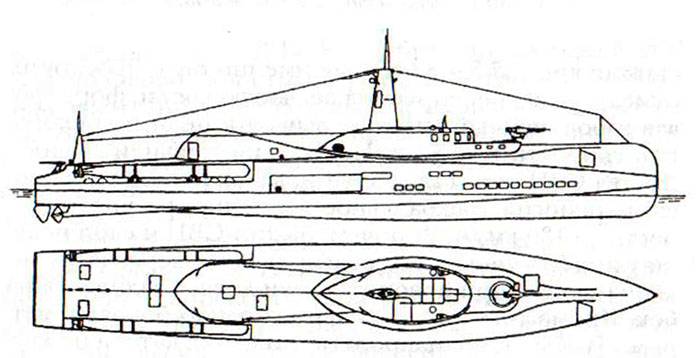
There is also the appearance of "Fleas-400"
But this ship, being the ideological heir of the “Bloch” for the big cruiser of the project “X”, was developed later, in 1939 by all the same Brzezinski VL, but ... no longer in TsKBS-1, but in OSTEHBYURO NKVD.
Reservation
As mentioned above, the reservation was supposed to provide a zone of free maneuvering in 30 cables against any “203-mm” cruiser. The basis for the calculations was adopted 203-mm British gun, because the developers considered it the best in the world at that time. According to the armor penetration formulas, to ensure the required level of protection, 115 mm vertical and 75 mm horizontal armor were sufficient. Accordingly, the cruiser was to receive a citadel from 115 mm of armor belt and traverses, on the upper edges of which an 75 mm mm armored formwork was placed. The citadel protected the engine and boiler rooms, as well as the cellars of the main caliber. In addition, some additional protection provided a large thickness of the sides and upper deck above the citadel - 25 mm.
The front plate of the towers of the main caliber should have been 150 mm, the side walls - 100 mm, the roof - 75 mm, barbety - 115 mm. Universal caliber towers and barbettes were defended with 50 mm armor.
The cruiser had two armored felling, and their upper tier had walls 152 mm, lower tiers - 75 mm, roof -100 mm
Power plant
Of course, it was proposed to equip the large cruiser with the most advanced, as it seemed, power plant. At this time, the Soviet fleet became interested in the idea of steam-turbine installations with high steam parameters. In 1935, the destroyer Experienced was laid (as an experimental ship). His power plant in size and mass should be the same as that used on the destroyers of the project 7, but at the same time exceed its power by 45%. It was assumed that with such an ES a new destroyer would develop an 43 node
The grounds for optimism seemed to be. Experiments in this area were conducted by the American firm General Electric, the Italian Ansaldo, and others. In England, the Thornycroft built the destroyer Acheron with an experimental power plant in 1930. "Passionate" direct-flow boilers and Germany. Something similar was supposed for the big cruiser of the “Project X” - the power of its power plant was to make phenomenal 210 HP, with which the ship’s speed reached 000 nodes.
It was assumed that direct-flow boilers will provide phenomenal economic speed - 25 nodes, but the range is known only that at full speed it had to be 900 miles. Obviously, it would have been much more economical.
Despite the presence of a single pipe, the cruiser provided for the echelon arrangement of mechanisms operating on two propellers.
Chassis
As is known, “length runs” - the longer the body, the easier it is to provide it with high speed. The length of the big cruiser “Project X” was 233,6 m, width - 22,3 m., Draft - 6,6 m. The ship’s standard displacement was to be 15 518 t. The weight of the cruiser is given in the Appendix.
What can you say about the project "X"? Alas, the enumeration of its shortcomings will take almost more space than the description of the ship itself.
The main caliber of a large cruiser with its 235 kg projectile with an initial speed of 940 m / s is obviously resurfaced. Let us not recall the 240-mm guns of the French battleships of the Danton type (220 kg and 800 m / s) - this is still a development of the beginning of the century, but installed on the Finnish coastal defense battleships 254-mm / 45 of the Befors gun of the 1929 g model fired 225 kg projectile with an initial speed of 850 m / s.
The maximum angle of the vertical pickup was supposed to be as much as 60 hail, but why are 240-mm guns? Not the planes of them were going to shoot, and in this case (walking for a walk!), An elevation angle of at least 75 degrees would be required. The only reasonable reason for such a request could be the desire to ensure the possibility of hanging fire on shore objects. But such angles of vertical alignment made the tower extremely complicated, so the game was not worth the candle.
Of course, 12 130-mm universal-caliber shafts were quite appropriate on a heavy ship, but other anti-aircraft artillery was provided for in an amount corresponding to the light cruiser “Kirov” - and even for him it was clearly insufficient, and only for a large cruiser, to which the standard “Washington "should have been on one tooth - and even more so.
But the torpedo armament raises no objections. Of course, all those interested in marine stories The successes of the Japanese cruisers armed with long-range torpedoes are memorable, but you need to understand that they needed numerous torpedo weapons to accomplish the main tactical task — the destruction of large enemy ships in night battles. But for the Soviet big cruiser such a task has never been set. He had to realize his advantage over the "Washington" cruisers in a day-to-day artillery battle, and there was no point in risking a heavy ship in night battles. Of course, the ships do not always fight in the tactical situations for which they were intended, but in such a case the two three-pipe torpedo tubes looked like quite reasonable minimums. Their increase, in turn, would entail additional risks in artillery combat, in which just a good hit could lead to the detonation of torpedoes and severe damage, if not even the death of the ship.
And besides, torpedoes for a raider are useful in a situation where, for whatever reason, it is urgently necessary to sink a large enemy vehicle.
Aircraft armament in the 9-12 aircraft seemed like an ingenious solution to the problem of day reconnaissance, but in fact would have resulted in endless take-off and landing operations, and would only constrain the cruiser. And this is not to mention the danger that the hangar and storehouses (or the fuel supply system) located outside the citadel would be exposed to in artillery fighting. It is also obvious that it is impossible to use seaplanes for air defense - in terms of their flying qualities they very much lost to both ground and deck aircraft.
The tactics of using submarines are completely incomprehensible - given their meager range of travel and autonomy, the big cruiser would have to take a lot of risk, bringing them to the object of attack, and then waiting for the operation to end so that they could be taken aboard. At the same time, a dozen 240-mm guns when attacking an enemy port would have given far greater effect than four 450-mm torpedoes in side torpedo tubes, which could only be fired at point-blank, and even in this case, having “excellent” chances to miss. In addition, the raid on the enemy base does not require a long stay of the cruiser in its area.
Booking does not cause any complaints, except for the length of the citadel, which was less than 50% of the length of the ship and therefore hardly capable of ensuring its unsinkability at an acceptable level. Thus, in the light cruiser Kirov, the length of the citadel was 64,5% of the length of the ship.
In addition, there are some doubts about the adequacy of 115 mm side armor against 203-mm armor-piercing shells. Designers of the big cruiser of the project "X" focused on the characteristics of the British eight-inch gun, assuming that by the middle of the 30-s it is the best in the world.
In fact, this is not true - the English 203-mm / 50 artillery system Mark VIII mod 1923 g fired 116,1 kg shells with an initial speed 855 m / s and was not at that time the most powerful, but rather, was a strong medium. For example, the French 203-mm / 50 model 1924 g shot 123,1 kg with a projectile with an initial speed 850 m / s, the Italian 203-mm / 53 model 1927 g - 125 kg with a projectile at a speed 900 m / sec, and the newly created German 203- m / 60 SK C / 34 sample 1934 g - 122 kg projectile with an initial speed 925 m / s.
Thus, we see another mistake, but, by and large, this is not a question for the designers of the big cruiser “X”, but for those who provided them with information on the performance characteristics of foreign weapons. Again, today we have at our disposal actual TTX of naval tools of that time, but does this mean that our designers also had them in 1935 r? Or maybe they thought the British gun was more powerful than it actually was? Unfortunately, the author of this article has no answer to this question.
The power plant of the “X project” looks extremely strange. Of course, speed is one of the most important indicators of a warship of those years, but why try to bring it to the 38 nodes? But ... as you know, in those years, the USSR worked very closely with Italy in terms of naval armaments and, of course, was aware of the results of sea trials of Italian heavy cruisers. In 1930, Trieste developed 35,6 bonds, a year earlier, Trento had 35,7, and in 1932, Bolzano showed enchanting 36,81 ties!
It is also impossible to completely exclude that in the USSR somehow obtained data on Japanese heavy cruisers: in 1928 g, ships of the Myoko type showed from 35,25 to 35,6 bonds, and in 1932, Takao showed approximately the same amount. Against this background, the task in 38 bonds for the Soviet big cruiser no longer looks like something transcendent.
Nevertheless, the attempt to deploy such a powerful power plant is certainly erroneous. Even knowing about the high-speed heavy cruisers of Italy and Japan, all the same it was necessary to remember that the Soviet cruiser (as well as any other warship) should be faster than those who are stronger than him, and stronger than those who are faster. The tactical and technical characteristics of the big cruiser of the project "X" provided him with superiority over the "Washington" cruisers of Italy and Germany, so why try to be faster than them? Or did the designers, as in the case of the artillery of the main caliber, prefer to "recast" the future, in fear that the speed of foreign battleships would grow to 35-36 bonds?
To ensure such a high speed, the big cruiser of the project “X” required a super-power, but compact power plant, which could only be obtained using direct-flow boilers and increased steam parameters, so this step looks logical. But the optimism of the designers is striking - on a power plant with a capacity of 210 ths. Hp. total 2000 tons were allocated - and this was at that time, as the mass of 26 cruisers' mechanisms was already known, which was approximately 1834 tons (data from the 26-bis project) at rated power 110 thousand hp!
Shipbuilders were just preparing for the “Experienced” tab, the specific power of the power plant of which was to exceed the average power units of 7 project destroyers by 45%. In this case, the case is considered to be so new and unusual that the newest boiler-turbine installation was first preferred to “run in” on a non-serial ship. Consequently, the risks of not achieving record characteristics were fully understood, and it would be reasonable, before the end of the tests, to design KTUs for promising ships with an increase in power density lower than the “Experienced”, or at least not exceeding its 45%. But instead, the designers are putting into the project of a large cruiser a power plant, whose specific power by 75% exceeds the newly acquired, newest Italian model of EI for a light cruiser!
But you need to understand that the weight and size characteristics of the power plant for the large cruiser of the project "X" were of fundamental importance. After all, with an increase in their size, the length of the ship’s citadel would have to be increased, which significantly increased the displacement of the latter.
Attempting to provide a large 38 cruise speed to a nodal speed had other negative consequences — an excessively long but relatively narrow hull did not allow for some serious anti-torpedo protection. On the other hand, there were, nevertheless, between the engine and boiler rooms and the board, there were “inserts” of compartments - fuel storages, which to some extent could have weakened the disruption.
In addition, questions remain about the cruising range of the big project “X” cruiser. Unfortunately, only the range at full speed of the ship is given, but given that it is only 900 miles, it is extremely doubtful that the range of 12-14 nodes reaches at least 6 000 miles, and even this is not a good indicator for the ocean raider.
In general, it can be stated that a large cruiser type "X" could not be built in the form proposed by the designers. In the case of continuing work on this cruiser, we should have expected such significant adjustments to the project that, in essence, we would have been talking about another ship, created taking into account the experience gained in the development of the “Project X”.
But why did the creators of the “X project” make such a lot of mistakes in their work? In order to answer this question, one should take into account the huge “shipbuilding holidays”: from the time of the First World War and until the development of the “Project X”, the Russian Empire, and later on the USSR carried out only the completion and modernization of large ships, but not their new construction. Military equipment 20-th century, continuously improved in virtually all directions: more durable structural steel and armor, significant progress in the power of ship turbines, a huge increase in aviation capabilities and so on and so forth.
But the most important thing is that then, and today, at each moment in time, the designers of the warship are in a dilemma. Whether to use new technologies that have not been tested yet, hoping to surpass their opponents in case of success, but at the risk of failing to spend money and time on an unfit ship? Or will they rely on reliability, using time-tested solutions, and risk the fact that the enemy ships created using the latest achievements of scientific and technological progress will turn out to be much better and stronger?
In this difficult choice, the only "advisers" are the experience of designing and operating modern ships. In some cases, this experience is able to suggest the right decision, but in the USSR, which stopped building and developing heavy artillery ships for many years, this experience was not, and could not be. The country, in fact, mastered the pre-revolutionary "groundwork" of royal shipbuilding, created in the interval between the Russo-Japanese and the First World Wars. As a result, the designers of the large cruiser tried to compensate for the lack of experience, of course, with ingenious, but hardly able to withstand the test of practice solutions.
No need to blame the creators of the "project" X "" inability. And in the same way, it makes no sense to blame the Soviet leadership for refusing to build heavy ships in the first half of the 30-s - for this, the country had neither financial nor technical capabilities. The history of the design of the heavy cruiser project "X" teaches us only how dangerous breaks in the creation of complex weapons systems. You never need to think that now we have no money / time / resources, and we will not do it, and then, after 5-10-15 years, when the necessary funds appear, we are ordered by law! - and create a competitive weapon.
Even in conditions when the economy of the country does not allow us to create heavy ships, we are able to seek funds at least for R & D in this area. And therefore it is very important to maintain in acceptable technical condition and intensively exploit those few large surface ships that we still have.
From this point of view, the history of designing a large cruiser of the project "X" can not be considered a failure. Although it did not lead to the creation of an effective warship, it nevertheless gave our designers the experience that turned out to be in demand when designing new warships of the USSR.
The load of the masses of a large cruiser project "X"
Metal housing - 4 412 t
Work items - 132 t
Tree - 6 t
Coloring - 80 t
Insulation - 114 t
Cement flooring - 48 t
Equipment of premises, storerooms and cellars - 304 t
Ship systems and devices - 628 t
Electrical equipment - 202 t
Communication and control - 108 t
Liquid cargo in the hull - 76 t
Reservations - 3 065 t
Armament:
Artillery - 3 688 t
Torpedo - 48 T
Aviation - 48 t
Mine - 5 t
Trailing - 18 t
Chemical - 12 t
Mechanisms - 2 000 t
Sourcing and crew - 272 t
Displacement reserve - 250 t
Total standard displacement - 15 518 t
List of used literature
1. A.A. Malov, S.V. Patyanin "heavy cruisers" Trento "," Trieste "and" Bolzano "
2. A.A. Chernyshev "Maxim Gorky type cruisers"
2. A.V. Platonov "Cruisers of the Soviet fleet"
2. L.A. Kuznetsov Big Cruiser Project X, Gangut, 18 Edition

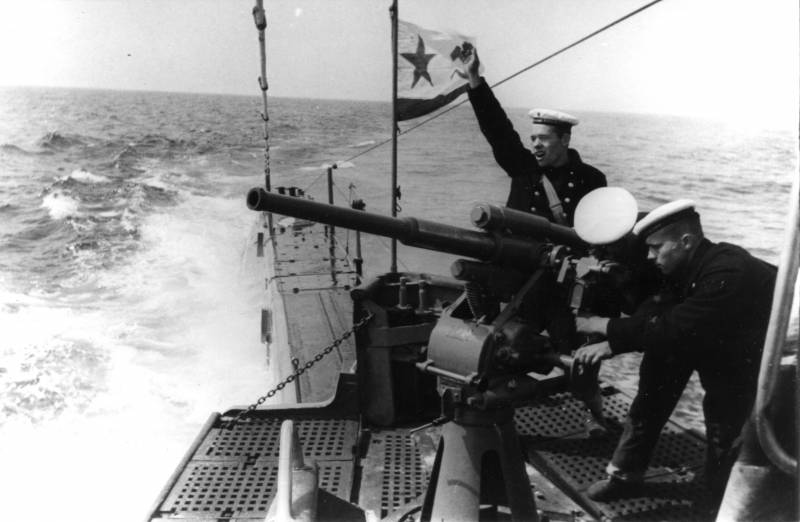
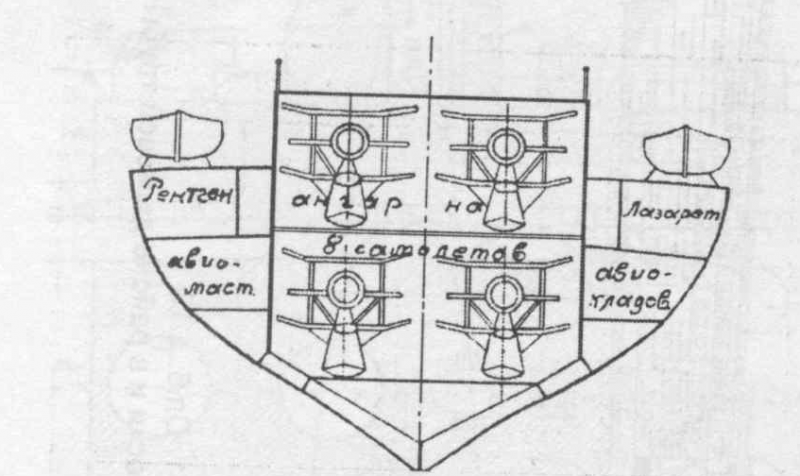
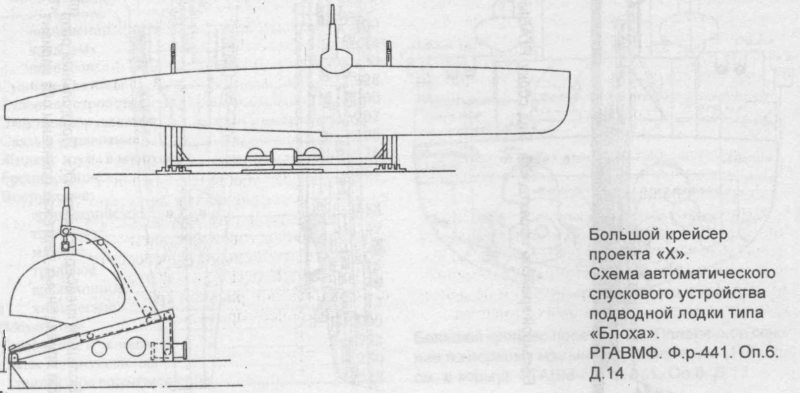
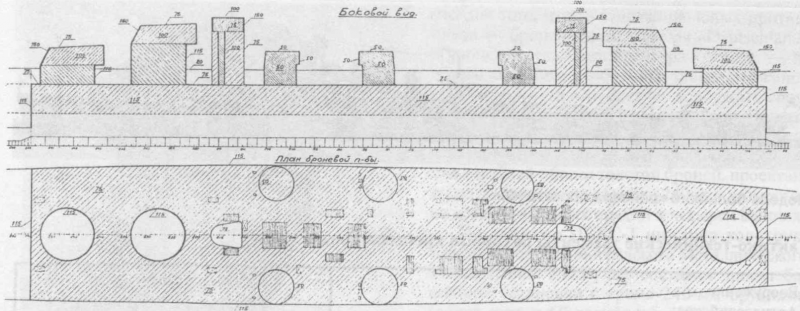
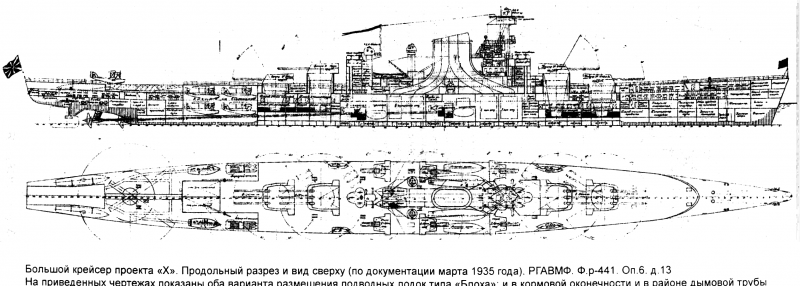
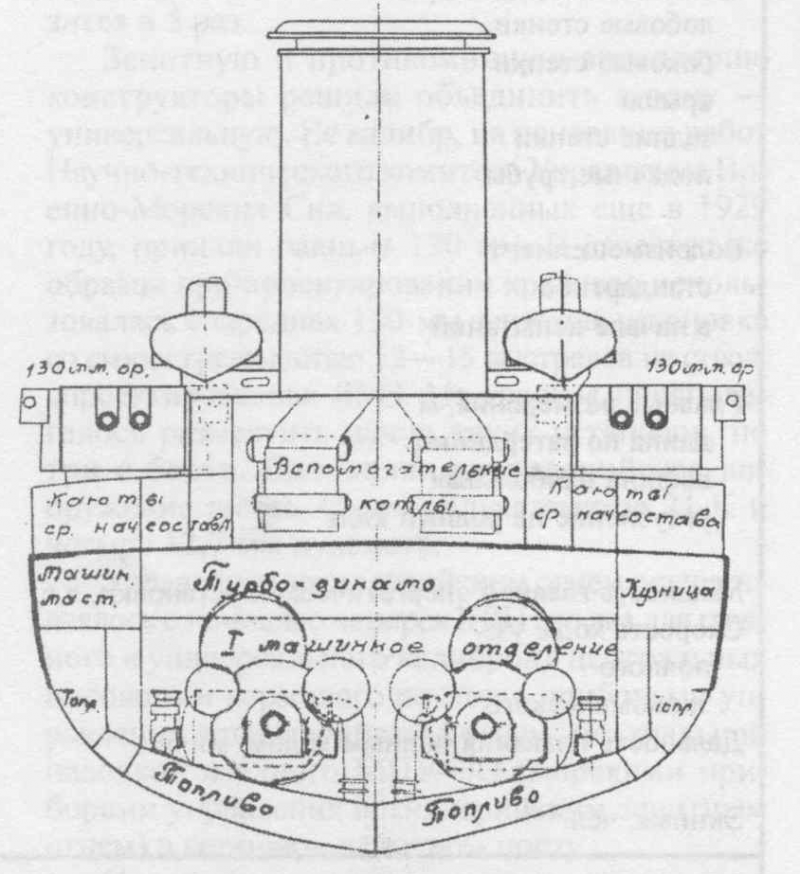
Information